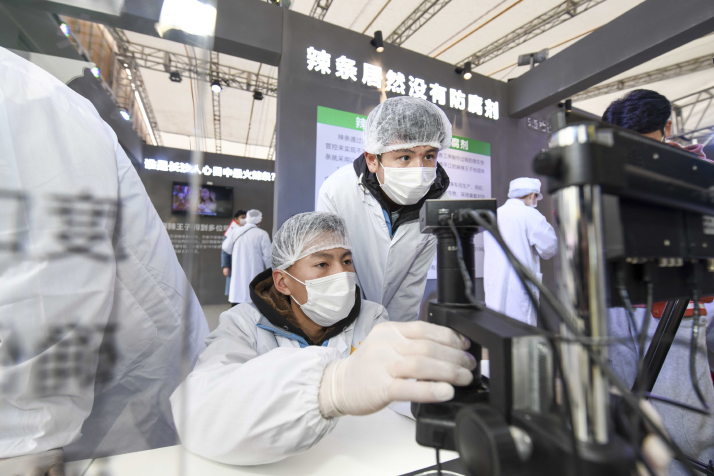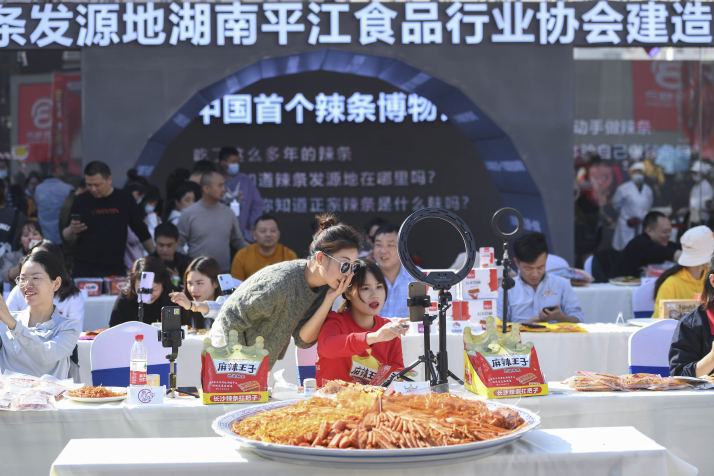| China |
| Latiao, a popular Chinese snack, is paving the path to prosperity in a rural area of central China | |
| Latiao, a popular crunchy snack similar to potato chips, is now available in over 160 countries and regions | |
|
|
 Students specializing in latiao production from Pingjiang Vocational-technical School in Changsha, Hunan Province, on December 10, 2020 (CNSPHOTO)
Among the current 15 top-selling Chinese snacks on eBay, four are latiao in different formats. Made from spices and flour with high gluten content, latiao, a popular crunchy snack similar to potato chips, is now available in over 160 countries and regions. In 2020, its production value reached 60 billion yuan ($9.2 billion), with 200,000 direct jobs created nationwide. The heart of the latiao empire is its birthplace - Pingjiang, a county located in Hunan Province in central China. But the snack was not always this popular. Development path In 1998, soybean prices in Pingjiang soared following a bad harvest caused by a historic flooding of the Yangtze River. As many dried soy sauce factories were going out of business, three manufacturers decided to take a gamble and replaced soy flour with wheat flour to make a paste and added spices to it. Thus the first latiao was born. Against all odds, this invention became hugely successful in the market, and many more workshops in the county began to follow suit. Since then, the snack has dramatically altered the development course of the county. Today, a total of 126 latiao manufacturers are located in Pingjiang, with a production value of about 20 billion yuan ($3.1 billion) and creating 70,000 jobs. As making latiao requires a long production chain, from farming to logistics and e-commerce, including food processing, packaging, and industrial manufacturing, an additional 100,000 indirect and induced jobs were created in the county with a population of barely 1 million. Besides, this sector's jobs are by far the best paid locally, with the average annual salary reaching 36,000 yuan ($5,537) in 2019. "The salary is enough for an employee to support his or her whole family," said Ye Jianzhi, Director of the Pingjiang Poverty Eradication Bureau. In the process, 5,000 households have been lifted out of poverty. However, faced with rising labor costs, local manufacturers are now looking to expand their operations throughout the country. As the figures show, there are as many as 10,000 latiao companies throughout China, 90 percent of which are owned by the residents of Pingjiang. As a result, the county has been officially granted the certificate of the birthplace of the snack by the China Agribusiness Association. Quality improvement However, latiao has not always enjoyed this level of popularity. Its success was accompanied by significant criticism. Consumers had doubts in the safety of this snack. Latiao was once considered "unhealthy and unsanitary." This has led some business leaders, including Zhang Yudong, founder of the famous Malawangzi brand, to call for a standardization of the production process. Answering the call, the stakeholders in the sector have taken action. About 100 latiao manufacturers in Pingjiang shut down their operations to streamline production, and a 24-hour hotline was set up at the local food association to collect reports of inappropriate behavior by manufacturers. The standardization campaign swept through the industrial landscape, resulting in halving the number of companies in the sector nationwide in 2013. In turn, the output value of the entire industry exploded, going from hundreds of millions of yuan to 40 billion yuan ($6.2 billion). At that time, the majority of manufacturers were already QS 9000 certified, with standardized production processes. But to improve their image, they still had to make efforts to enhance their manufacturing methods. To this end, Zhang set up an R&D center on healthy latiao in Changsha, capital city of Hunan, in 2013. He also invested 30 million yuan ($4.6 million) to build a high-level workshop with impeccable sanitary conditions. Zhang's company now uses premium quality raw materials, favoring natural flour and non-GMO frying oil. He also insists on avoiding synthetic colorants, artificial flavors, synthetic preservatives, and other chemical substances. For the company manager, "constantly improving quality is a crucial step in obtaining the public's approval." His move has been emulated by many of his peers. As a result, fully automated and aseptic workshops, smart production lines, etc., are gradually appearing throughout the industry. Since 2019, 12 manufacturers in Pingjiang have invested 13 million yuan ($1.99 million) in their sanitation projects, and 52 companies have spent 30 million yuan ($4.6 million) on equipment upgrades.  Latiao manufacturers from Pingjiang participate in a live broadcast to promote their products in Changsha, Hunan Province, on November 10, 2020 (CNSPHOTO)
Beyond standardization Standardization of the industry appeals to consumers, but it is not enough to ensure its sustainability. The Pingjiang government keeps an eye on every trend to make latiao a springboard for rural revitalization. Last year, livestreaming was especially popular in e-commerce. Yang Yu, deputy head of Pingjiang County, jumped on board. He now offers regular live broadcasts on latiao, followed by thousands of subscribers. He uses this opportunity to promote their products by demonstrating the production lines of workshops. Meanwhile, Pingjiang Vocational-technical School inaugurated its first course dedicated to latiao on September 15, 2020. It is also the first of its kind in the country. The 59 students from the first cohort are now taking courses on extrusion mechanism, food quality and safety, and marketing. After three months of training, the students' skills and mastery of industrial production equipment, among other things, are strictly evaluated. The final grade in the examination must be greater than or equal to 90/100 to validate the training. Enjoying a surge in consumer demand, the first latiao-related museum opened in Changsha on November 1, 2020. In just 10 days, the site recorded 100,000 admissions, emerging as a new popular tourist destination. The visit in the museum allows the public to review the history of latiao in Pingjiang and to discover the raw materials used, the production process, and the machinery involved in the industrial chain. These joint efforts push Zhang to continue to aim higher. He even plans to register Pingjiang latiao as a protected geographical indication, to enhance its reputation in China and abroad. CA (Print Edition Title: A Model of Resilience) Comments to lixiaoyu@chinafrica.cn |
|
||||||||||||||||||||||||||||
|
